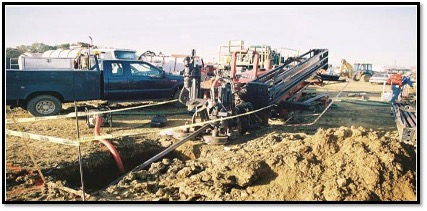As consultants continue exploring the benefits of horizontal remediation wells, they are often confronted with deciphering the difference between remediation and utility directional drilling. While many directional drilling companies exist and do an excellent job installing subsurface utilities, Directional Technologies specializes in designing, drilling, and installing horizontal remediation wells. Even for the most experienced environmental consultants, utilizing a foreign technology can be an intimidating endeavor – particularly when remedial expectations of the client are a high priority. While effective designs are critical to successfully bringing a remedial project to closure, the execution of those designs during the installation of the wells must be flawless to achieve the desired results. For this reason, the Directional Technologies team comprises highly technical horizontal directional drillers who fully comprehend the importance and application of the wells they are installing.
Directional Technologies’ HRW Driller Qualifications
At Directional Technologies, a qualifications criterion was developed to ensure that the drilling team has the appropriate technical background and understanding of the site to drill and install horizontal remediation wells for the desired application. A master driller at Directional Technologies must have completed installations on at least ten or more different environmental projects and drilled at least 5,000 linear feet of borehole length. These criteria ensure that the lead driller has performed horizontal well installations on projects involving a variety of contaminant constituents (chlorinated solvents, fuel byproducts, heavy metals, etc.), multiple lithologies, widespread site conditions, and has a full understanding of how each of these elements interacts. These qualifications ensure the utmost professionalism is put forth to ensure that the contractor and client’s expectations are met.
Site-Specific Understanding for Successful HRW Installations
Successfully installing horizontal remediation wells requires a complete site-specific understanding of the site, from a management level to operational implementation. Our drillers arrive on-site with a comprehensive understanding of the expected lithology, the application of the horizontal remediation wells being installed, and an understanding of why the well must be installed in its designed layout. Inexperienced drilling personnel or drillers unfamiliar with remediation-based projects may not consider how the screened interval of the well must communicate with the geologic formation around it. This lack of knowledge can have catastrophic consequences regarding the success of the application of the well, highlighting the importance of a horizontal drilling team with remedial specialization.
In the world of soil and groundwater remediation, expectations rarely transfer to reality. For example, it is not uncommon for unexpected clay layers to emerge or groundwater fluctuations to be more pronounced than expected. In these instances, when the implementation phase is already underway, it is critical to have an experienced driller on site who has the practical knowledge and background to communicate any last-minute design changes that may occur. Alterations to the mud program or slight variations to the bore path may be critical game-time decisions to ensure strong communication between the well and the surrounding formation. However, these observations can only be detected by an experienced driller looking for them.
Directional Technologies Health and Safety Advantages
Working almost exclusively in remediation project settings, our drilling personnel have an advanced perspective on health and safety concerning contamination. The Directional Technologies drilling team is well-trained in safe practices when handling contaminated soil and groundwater and entrusted when waste containment is paramount to the client’s expectations. The nature of horizontal directional drilling also has inherent health and safety benefits despite the bore path typically leading beneath existing facilities, roadways, and active businesses. Contrary to what is often expected, directional drilling processes allow for avoiding many health and safety issues associated with vertical drilling. Subsurface contamination often lies directly below high-trafficked areas, such as roadways or active runways. When a vertical rig would need to be staged directly in these hazardous zones, the directional drill rig can be set up in locations away from the target area while continuing to provide direct access to the contamination.
Conclusion
The academic background and practical work experiences of the Directional Technologies staff demonstrate a practical understanding of drilling, engineering, geology, mechanics, and mud mixing. The variable project experience of the drilling team has led to the successful installation of hundreds of horizontal remediation wells across the country and internationally. This wide range of expertise allows the company to complete previously considered unfeasible projects, allowing unparalleled access to subsurface contamination to bring sites to closure quickly.
How can the advantages of decades of technological advancement in horizontal wells benefit your project? Call our horizontal remediation well experts at 1-877-788-4479 to discuss your current project needs, or email us at drilling@directionaltech.com with questions, review case studies, and learn more.
Written by: Elliott Andelman, Technical Environmental Scientist
